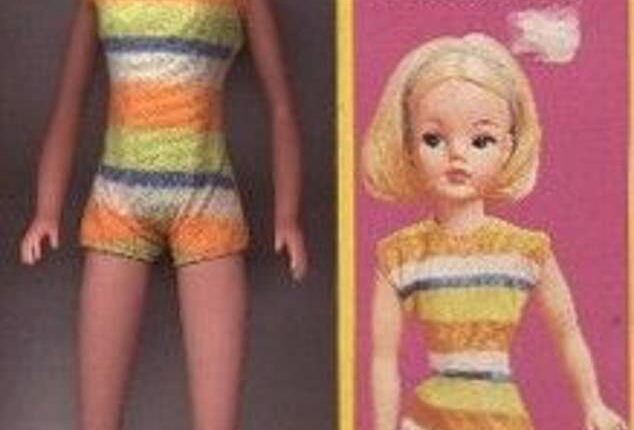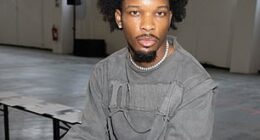All of us have a beloved childhood toy we fondly remember, be it a Beanie Baby or an Etch a Sketch – but what was the most popular item in the year you were born?
New research from the Toy Retailers Association has unveiled what the top five most popular Christmas toys have been each year over the past decades, starting from 1970 up until today.
The list also shows the effect of inflation on your shopping list.
In 1980, a Rubik’s Cube would have set you back 91p – £3.94 in 2025 – whereas the more substantial Lego Train Set cost £40 back then, the equivalent of £173.28 today.
Meanwhile in the 90s gadgets such as the mini electronic Dear Diary machine (£23.99 in 1994, £51.10 today) and the beloved Furby (£24.99 in 1998, £53.23 today) were prized possessions for kindergarteners across the nation.
Today, however, children are delighting in the Mini Brands and the Bluey toy ranges.
Read on below to see what was hitting department store shelves in the year you were born and how much they would cost when put in line with inflation today…
1970s
From the famous Sindy dolls to space hoppers and Etch a Sketch, the 1970s were full of fun and creative non-digital toys.
Those who grew up in this era might remember begging their parents for some of the most popular choices on the market, from the board game Risk, to walkie-talkies (deemed to be mind-blowing technology as a child back then) or an Easy Bake oven.
However, back then, each of these toys had starkly different price tags compared to how much they would cost now. In 1975, Monopoly set households back £1.89 – which is the equivalent of £14.82 in today’s prices when adjusted for inflation.
It was a simpler time, when portable cassette players were the closest thing people had to iPods and Spotify and e-bikes did not exist – instead, skateboards were the chosen way to get around town…

1970: Sindy Cost then: £3.99 Cost now: £55.25 Sindy was created in Britain by Pedigree Dolls & Toys in 1963 as a more wholesome rival to Barbie, and she became the best-selling toy in the United Kingdom in 1968 and 1970.

1970: Risk Board Game Cost then: £1.73 Cost now: £23.95 The board game is a strategy game for children and adults, which became one of the most popular games in history

1971: Space Hopper Cost then: £2.25 Cost now: £28.71 The space hopper, a large vibrant rubber ball with handles to bounce around on, became all the rage for decades to come.

1971: Etch a Sketch. Cost then: £0.99 Now: £12.63 The mechanical drawing toy invented by André Cassagnes of France and subsequently manufactured by the Ohio Art Company is a thick, flat grey screen in a red plastic frame, which lets users create a drawing on screen using two knobs, and erase it with one swipe

1972: Skateboard Cost then: £3.62 Cost now: £38.98. Skateboards were introduced in the 1940s by surfers who wanted to stay active in the absence of waves

1972: Easy Bake Oven Price then: £3.99 Price now: £47.71. These ovens were introduced in 1963. It was a working toy that children could use to make easy cakes

1973: Walkie Talkie sets Price then: £4.98 Price now: £54.67. Walkie talkie sets allow people staying at a short distance from each other to communicate

1973: Baby Alive Price then: £10.88 Price now: £199.43. Introduced in 1973, the Baby Alive can eat, drink and make messes with its movable mouth

1974: Twister Cost then: £1.35 Cost now: £12.92. The Twister game comprises a large plastic mat spread across the ground with six rows of large coloured circles on it in different colours – red, yellow, green and blue. A spinner is attached to the board, which determines where each player will place their hand or foot and the person who stays still and able to keep their position wins the game

1975: Portable Cassette Player Recorder Cost then: £12.40 Cost now: £97.23. Portable Cassette Player Recorders delighted music lovers as they allowed people to walk around with their music in their ears for the first time

1975: Monopoly Cost then: £1.89 Price now: £14.82. The game Monopoly sees players roll two six-sided dice to move around the board, buying and trading properties and developing them into houses and hotels. Players collect rent from other players when they land on their houses, driving them into bankruptcy

1976: Kites Cost then: 95p Cost now: £6.46. The history of the kite dates back to 200 BC, but they became especially popular in the ’70s, when Peter Powell designed a special stunt kite and the hobby of flying kites became hugely fashionable, outselling Lego in 1976

1977: The Batmobile Cost then: £20.71 Cost now: £122.84. The toy car was modelled on the popular Batman character and was a hit in the seventies.

1977: Portable 8 track player: Cost then: £21.22 Cost now: £125.86. A portable music player similar to a boombox

1978: Hungry Hippos. Cost then: £3.94, Cost now: £21.74. Tabletop game for 2–4 players, with each person trying to collect as many marbles for their own hippo as possible

1979: Sony Walkman Cost then: £81.67 Cost now: £405.96. The original Walkman portable cassette player, released July 1, 1979, and even had two ports to allow two people to listen at once

1979: Lego Space Cost then: £16.98 Cost now: £84.40. Legoland Space was a Lego set based on space and the year was dubbed ‘the golden age of Lego’
1980s
A decade later, tastes had changed and puzzle-solving and creative toys such as the Rubik’s Cube and Lite-Brite took to the shelves and were a hit.
Some of the defining products from this era include the LEGO Train Set, which cost £40 back then, equivalent to £173.28 in today’s money.
The neon green Glow Warm was another popular choice. The plush toy, created by Hasbro that contained a battery-powered device which would light up the toy’s head from within when squeezed, cost £4.99 back then, which would be £17.10 today.
Towards the end of the 1980s, Sylvanian Families, a series of collectable furry figures, grew in popularity, priced at £6.97 back then, which would be £20.35 now.

1980: Originally called magic cubes, are still widely considered to be the world’s best-selling toy. The 3-D puzzles have six faces covered by nine stickers, with the aim of making each side one colour. Price then: 91p Price now: £3.94

1980: The popular sets included locomotives, tracks, rolling stock, stations, signal boxes .Price then : £40 Price now: £173.28

1981: Users could create LED images freehand or using templates. Price then: £14.99 Price now: £58.34

1981: Madame Alexander’s ‘Baby Precious’ was a popular dress up doll. Price then £8.05. Price now: £31.33

1982: BMX bikes are specially designed for off-road adventurers. Price then: £45 Price now: £161.98

1982: The Glo Worm was a plush toy created by Hasbro that contained a battery-powered device which would light up the toy’s head from within when squeezed. Price then: £4.99 Price now: £17.96

1983: Care Bears were a hit in the 80s – providing a plush companion to children everywhere. Price then: £16.75 Price now: £57.49

1983: My Little Pony toys have generated a huge fandom among grown-ups to this day. Price then: £3.55 Price now: £12.19

1984: Pound Puppies were a line of stuffed dog dolls with floppy ears and droopy eyes. Price then: £6.99 Now: £22.98

1984: Tonka GoBots inspired an animated series and follow-up film based on their universe. Price then: £5.39 Price now: £17.72

1985: The Care Bear Desk and matching seat was a hot commodity in the 80s. Price then: £18.43 Now: £57.63

1985: The Wuzzles were plush toys based on Disney’s hit television animated series. Price then: £11.06 Now: £34.58

1986: Lazer Tag is played with guns that fire infrared beams at targets worn by each player. Price then: £34; Now: £102.52

1986: The Power Wheels Jeep was the first of many miniature versions of popular real world vehicles. Price then: £112.32 Now: £338.69

1987: Sylvanian Families are a series of collectible furry figures created by the Japanese gaming company Epoch. Then: £6.97 Now: £20.35

1987: Jem Dolls were collectible fashion dolls based on the TV series Jem and The Holograms. Price then: £8.95 Now: £26.14

1988: Ghostbusters Fright Features are miniature versions of popular characters from the American fantasy comedy film. Price then: £3.78 Now: £10.62

1988: The Playskool Kitchen remains a widely popular toy set. Price then: £50.54 Now: £142.05

1989: Polly Pocket toys were a line of tiny collectible dolls. Price then, £5.50 Now: £14.69
1990s
As technology usage began to increase, the 1990s were filled with innovative toys, such as the Nintendo Game Boy and the Sega Game Gear.
The latter set parents back £97.95, the equivalent of £554.05 if you were to buy it in line with inflation today.
However, Barbie and Action Man were still classics that kids still went for, and they were equally a lot cheaper for parents to purchase.
A Barbie doll back then was priced at £10.99, which would now cost £23.88 and Action Man, which had an RRP of £9.99 back in the 1990s would cost £21.70 now.

1990 Teenage Mutant Hero Turtles Action Figures. The action figure toys were based on the franchise of the same name. The film was very popular amongst children at that time. Cost then: £3.99 Cost now: £9.96

1990 Polly Pocket. Polly Pocket toys were miniature dolls complete with accessories, which have now become valuable collectables. Cost then: £4.95 Cost now: £12.36

1991 Sega Game Gear. The game console was originally released in Japan as a competitor to Nintendo’s Game Boy and featured a full-colour, backlit screen with a landscape format. Cost then: £189.99 Cost now: £227.43

1991 Super Soaker. First released in 1989, the super soaker was a recreational water gun that used manually-pressurized air to shoot water. Cost then: £9.99 Cost now: £23.20

1992 WWF Action Figures. Produced by the toy company Hasbro between 1990 and 1994, these action figures were toy versions of the World Wrestling Federation performers. Cost then: £4.99 Cost now: £11.12

1992 Super Nintendo Entertainment System. This was a home video game developed as Nintendo’s second programmable console. Cost then: £99.99 Cost now: £222.74

1993 Action Man. Action Man was launched in 1966 as a ‘movable action figure’. Originally, there was the option to buy different outfits for the figure. Later, it was possible to buy individual figures with different outfits and equipment tailored to specific missions. Cost then: £9.99 Cost now: £21.70

1993 Barbie Doll. The Barbie Doll was first released in 1959 and appeared in countless versions to reflect the various trends of the day. It made a comeback in 1993. Cost then: £10.99 Cost now: £23.88

1994 Dear Diary. Dear Diary was a bright pink mini electronic diary for young children to use on a daily basis. Cost then: £23.99 Cost now: £51.10

1994 Power Ranger Action Figures. Power Ranger Action Figures were based on the popular Power Rangers series, which saw the characters battling evil forces. Cost then: £4.99 Cost now: £10.63

1995 Beanie Baby. Beanie Babies started out in 1986 as collectible soft toys. Cost then: £3.99 Cost now: £8.28

1996 Tickle Me Elmo. Tickle Me Elmo was a children’s plush toy resembling Elmo from the children’s television show Sesame Street. It vibrated and giggled when squeezed. Cost then: £19.99 Cost now: £40.51

1996 Buzz Light Year. The Toy Story figures were released following the success of the computer-animated hit comedy film, which first hit screens in 1995. Cost then: £23.99 Cost now: £48.61

1997 Tamagotchi. The Tamagotchi was a handheld digital pet. Created in Japan in 1996, it grew to become a global phenomenon. Cost then: £9.99 Cost now: £19.88

1997 Teletubbies. In March 1997, the first episode of Teletubbies aired on BBC 2 for small children. It quickly became a hit and toy versions of the characters sold out. Cost then: £27.99 Cost now: £55.70

1998 Furby. Furbies were fluffy electronic robot toys. Sales reached more than 40 million and the toy’s voice was translated into 24 languages. Cost then: £24.99 Cost now: £48.97

1998 The Game Boy Color. The Nintendo Game Boy Color was the second edition of the Game Boy Family and featured games cartridges such as Kirby Tilt ‘n Tumble and Chee-Chai Alien Cost then: £69.99 Cost now: £137.15

1999 Pokemon Red. Pokémon Red and Blue were role-playing video games for the Nintendo Game Boy and were the first installments of the popular Pokémon video game series. Cost then: £19.99 Cost now: £38.66

1999 Blue and Tyco Rebound. The Tyco Rebound was a battery powered, remote-controlled electronic toy monster truck that could automatically flip itself off the ground. Cost then: £75 Cost now: £145.04
2000s
As we hit the 2000s, parents of those in their twenties and thirties will remember the frightening breakthrough of digital and technological games.
It seems as though every child was after either a Teksta Robotic Dogs, a Sony PlayStation 2 and an iPod Classic – or all three.
Bratz Dolls, which were priced at £24.99 and would now cost £47.95, were also rivalling the likes of Barbie.
Video games were also growing in popularity, such as Grand Theft Auto: San Andreas and Halo 2.
Long gone were the days of the Sony Walkman and instead they were replaced with the iPod Nano (RRP £104.20, which would now be £151.11) and iPod Touch (RRP £141.05, which would now be £190.07).
2010s
With technology constantly improving, many brands rushed to incorporate it into their designs.
Twister made Twister Dance (RRP then £26.99, which would now be £39.18) and the Frozen Snow Glow Elsa doll (RRP then £34.99, which would now be £48.81) would have interactive elements.
The Sims and Grand Theft Auto then went on to make newer versions of their successful games with new plotlines.
However, Furby and Lego toys remained popular in the first half of the 2010s – until iPhones and Nintendo began to take over.

2000: It’s one of the first mobile phones of the new century – and is known to be one of Nokia’s most iconic devices. Price then, £150 Now: £287.79

2001: The Sony PlayStation 2 was a hit in the gaming community. Price then £299 Now: £566.67

2001: The iPod classic elevated the world of portable MP3 players when it came out. Price then £273.47 Now: £518.29

2002: These glam dolls had big heads with exaggerated features and were dressed to the nines. Price then £24.99 Now: £46.77

2002: The Xbox proved to be yet another successful console for gamers. Price then £299.99 Now: £561.48

2003: This clever machine tapped into the Y2K penchant for strong accessories. Price then £15 Now: £27.70

2003: These spinning toys from Japan started a craze on school playgrounds all over the world. Price then £5.99 Now: £11.06

2004: Grand Theft Auto: San Andreas remains a cult classic game to this day. Price then £29.99 Now: £54.64

2004: Grand Theft Auto: San Andreas remains a cult classic game to this day. Price then £29.99 Now: £54.64

2004: This adorable tiny robot could react to voice and touch. Price then £74.97 Now: £136.60
2005: The 360 version of this iconic gaming console was even more popular than its predecessor. Price then, £299. Now: £533.81

2005: These portable friends are having a resurgence today. The Tamagotchi Connexion cost £13.06 then and is Now: £23.32 now

2006: Sparking a whole new meaning to family game night, Nintendo wowed shoppers when it came out with the Wii. Price then, £169. Now: £294.85

2006: Introduced as a robotic alternative to live pets, the Furreal animals were popular for their animatronic features and came in diverse sizes. Price then £206.26. Now: £359.86

2007: The aim of the game was to hit as many notes as possible while playing a song with the help of small guitars. Price then £69.70 Now: £118.84

2008: This High School Musical Dance mat (pictured), used to be £17.99 Now, it costs £29.61

2009: These plush robotic toys were known as ‘Zhu Zhu’ pets in other country. Price then, £9.99 Now: £16.09

2009: To play with these magnetic spinning toys, children had to use one assembled top. Price then: £9.99 Now: £16.09

2010: The nerf blasters toys series started in 2003. The 2010 entry could be customised with different accessories. Price then: £54.99 Now: £85.76

2011: Pictured, the Nintendo 3DS. Priced then: £126.60. Priced ow: £188.99

2013: A dream for many, the first hoverboard to be commercially released was popular with celebrities such as Justin Bieber. Price then: £229.42 Now: £324.74

2018: LEGO Harry Potter Hogwarts Great Hall. Price then: £87.95 Now: £115.79

2019: Pictured, the Nintendo Switch Lite. Its price then was £199 Now: £257.39
2020s
The 2020s saw Monopoly manage to get back onto the Dream Toy’s top 12 list with their version named Sore Losers, which cost 22.99 back then, which would now be £29.48, five years later.
Barbie has also appeared to have a resurgence, with two of the range making it onto the list, the Barbie 3-in-1 DreamCamper and the Barbie Dreamtopia Rainbow Magic Mermaid.
Bluey, an animated television series about a young blue puppy named Bluey who lives with her family, has grown in popularity among young children.
This has led to ranges such as the Bluey 3-in-1 Transforming Plane Set and the Bluey Family Home Playset, making them some of the bestselling toys.
Mini Brands, which are collectable toys featuring miniature replicas of real-life household, food, and other popular products, are also a defining toy of the 2020s.

2020: Tapping into the trend before the memorable movie release, kids were obsessed with Barbie Dreamtopia Rainbow Magic Mermaid. Price then: £27.99 Now: £34.99

2022: Pokemon continues to have a legacy as a beloved toy brand. Its Elite Trainer Box used to cost £42.50 but is now worth £48.70

2024: The Despicable Me 4 The Ultimate Fart Blaster gun used to cost £29.99 – but is now £31.24

2024:The Bluey 3-in-1 Transforming Plane Set is popular with fans of the hit children’s show. Then, £59.99 Now: £62.50

2025: The Hot Wheels Racing F1 Grand Prix Circuit, which costs £79.99, is a big hit this year

2025: Another beloved item is the Gui Gui Shimmer Deluxe Pack – which costs £19.99

2025: The Mini Brands – Fill the Fridge Playset (£19.99) has been a big hit with children and parents alike









